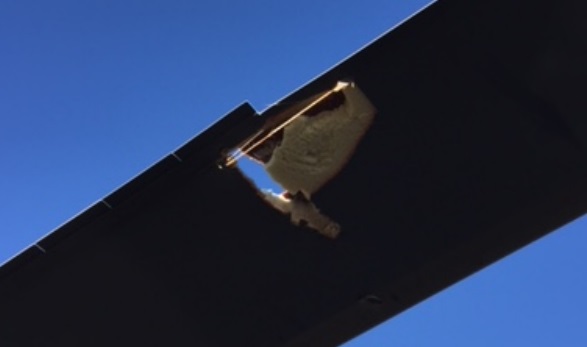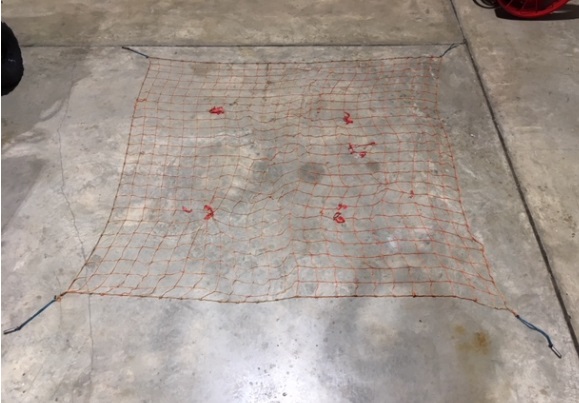Helicopter Wildlife Netting Accidents (N338HW, N22TZ, N369TH, C-GTNV, N122CH)
In May 2018 the US National Transportation Safety Board (NTSB) published two reports into accidents involving helicopters attempting to carry out wildlife net captures. UPDATE 11 July 2019: Another netting accident report is published. UPDATE 8 November 2019: …and another. UPDATE 13 February 2020: …and again; the fifth accident in just 18 months.
1) Tail Rotor Strike, N338HW
On 12 February 2018, Hughes (later MD) 369D N338HW of Helicopter Wildlife Services was manoeuvring at a low altitude in an attempt to net an elk near Heber City, Utah. According to the NTSB report:
When the helicopter was approximately above the elk, his attention was immediately focused forward due to a small rise in terrain. He pitched the helicopter’s nose up, and the helicopter started to shake and spin. Subsequently, the helicopter struck the ground, the right skid broke, and the helicopter came to rest on its right side.
Postaccident examination revealed that the tail rotor had struck the elk when the pilot pitched the helicopter’s nose up.
Wreckage of Hughes 369 N338HW: note missing tail rotor an main rotor blade damage (Credit: FAA via NTSB)
The helicopter sustained substantial damage to the tailboom and rotor [sic].
The two persons on board were uninjured. NTSB do not comment on the fate of the elk, but other sources state its injuries were terminal.
The NTSB probable cause was:
The pilot’s failure to maintain clearance from an elk while maneuvering at a low altitude.
Successful elk captures to fit radio collars in New Mexico:
2) Self Inflicted Main Rotor Damage, N22TZ
A few months earlier, on 26 October 2017 in La Paloma, Texas, Airbus Helicopters EC130T2 N22TZ of Richardson Aviation was manoeuvring at low altitude with two net gunners located on the left and right in the aft cabin according to the NTSB report.
The pilot reported that he entered a left bank to pursue a deer. The deer was located “between our 8 and 9 o’clock position, and the net gunner made the net shot at the deer.” The pilot observed the net miss the deer and simultaneously heard an unusual “whooshing noise” coming from the helicopter.
He made a precautionary landing, and during the shutdown, he noticed what he described as an unusual discoloration of the main rotor disc.
Examination of the main rotor blades revealed that one of the blades had a large hole in it, about 5 ft from the blade tip.
The net that was fired at the deer was recovered and was found to be missing one of the weights that are normally attached to the net’s corners.
The NTSB probable cause was:
The separation of a weight from the gunner’s net, which struck the helicopter’s main rotor blade during flight.
UPDATE 11 July 2019: 3) Self Inflicted Tail Rotor Damage, N369TH
On 27 January 2018, Hughes 369D N369TH, operated by Hells Canyon Helicopters (seemingly on contract to the Washington Department of Fish and Wildlife) crashed NW of Pomeroy, Washington. One person died and two were seriously injured.
According to the NTSB safety investigation report (and on-site supplement):
The purpose of the flight was to capture and collar mule deer for tracking. The flight was operated with three crew members: a pilot, a gunner, and a mugger. The pilot sits in the front left seat, the gunner sits in the rear left seat and shoots nets from a net gun in order to capture deer, and the mugger sits in the front right seat and exits the helicopter to handle the tagging and release of the deer.
Neither survivor could remember much about the accident.
The tail rotor hub and stop exhibited contact marks and dents consistent with excessive tail rotor blade flapping. One blade appeared undamaged, and the outboard 2 inches of the second blade had a dent with gouge marks with evidence of metal transfer consistent with stainless steel, similar to that of the net weight; the remaining section of the blade was bent and curled.
…it is likely that the net weight struck the leading edge of the tail rotor, which resulted in a fracture of the tail rotor tip and subsequent imbalance of the tail rotor blades. This imbalance resulted in excessive tail rotor blade flapping and subsequent loss of control.
…addition, since there are several accounts of windy conditions it is potential that the wind affected the nets ability to open and possibly the net trajectory.
The NTSB probable cause was:
A loss of control following the gunner’s failure to ensure that the net maintained clearance from the tail rotor.

Accident Site Hells Canyon Helicopters Hughes 369D N369TH near Pomeroy, Washington (Credit: via NTSB)
UPDATE 8 November 2019: 4) Self Inflicted Main Rotor Damage, C-GTNV
According to an NTSB report, on 31 March 2019 near Coldfoot, Alaska Airbus AS350B C-GTNV…
…while attempting to net a calf during a caribou capture flight, …got within shooting range for the net gun, but the calf suddenly “broke right.”
[The pilot] then turned the helicopter to follow the calf, and while turning, the pilot thought the shot would not be possible and that he should set up for another run, but the gunner fired. The pilot heard a “bang,” followed by a strong vibration. The pilot landed the helicopter without further incident.
The pilot reported that postaccident examination revealed that one of the main rotor blades had sustained substantial damage, which he assumed was from a net weight.
UPDATE 13 February 2020: 5) Net Ensnared Bull and Skid, N122CH
The NTSB report that on 26 June 2018 that R22 N122CH was manoeuvring at low altitude in Encino, Texas to net a bull. “…the gunner fired…the net deployed” but it “ensnared the helicopter’s skid and the bull. The bull continued to run, dragging the helicopter down, which resulted in the helicopter’s collision with terrain”.
Other Safety Resources
- NTSB Comes Out For Gun Control: The butt of a hunter’s gun became lodged in the cyclic control during a feral hog hunting flight in Texas.
- EC120 Underslung Load Accident 26 September 2013 during reindeer herding in Sweden.
- Keep Your Eyes on the Hook! Underslung External Load Safety
- Unexpected Load: AS350B3 USL / External Cargo Accident in Norway
- Unexpected Load: B407 USL / External Cargo Accident in PNG
- Fatal H500 / 369D Low Altitude Hover Power Loss: Power Line Maintenance Project
- UPDATE 28 July 2018: Wayward Window: Fatal Loss of a Fire-Fighting Helicopter in NZ
- UPDATE 1 December 2018: Helicopter Tail Rotor Strike from Firefighting Bucket
- UPDATE 11 April 2020: Bear Paws Claw Reindeer Herding Bell 206
- UPDATE 26 July 2020: Impromptu Landing – Unseen Cable






Recent Comments